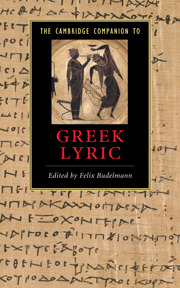Book contents
- Frontmatter
- Introducing Greek lyric
- Part I: Contexts and topics
- 1 Genre, occasion and performance
- 2 Greek lyric and the politics and sociologies of archaic and classical Greek communities
- 3 Greek lyric and gender
- 4 Greek lyric and the place of humans in the world
- 5 Greek lyric and early Greek literary history
- 6 Language and pragmatics
- 7 Metre and music
- Part II: Poets and traditions
- Part III: Reception
- Chronology of select melic, elegiac and iambic poets
- Further Reading
- Glossary
- List of works cited
- Index
3 - Greek lyric and gender
from Part I: - Contexts and topics
Published online by Cambridge University Press: 28 May 2010
- Frontmatter
- Introducing Greek lyric
- Part I: Contexts and topics
- 1 Genre, occasion and performance
- 2 Greek lyric and the politics and sociologies of archaic and classical Greek communities
- 3 Greek lyric and gender
- 4 Greek lyric and the place of humans in the world
- 5 Greek lyric and early Greek literary history
- 6 Language and pragmatics
- 7 Metre and music
- Part II: Poets and traditions
- Part III: Reception
- Chronology of select melic, elegiac and iambic poets
- Further Reading
- Glossary
- List of works cited
- Index
Summary
Introduction
'Gender' is pervasive and polymorphous. I take gender to be a socially constructed matrix of identity, based on a rigid division of people into two biological categories. It covers social roles assigned on the basis of that biology, including sexual roles, but also ideological constructions, which prescribe the values to be attached to bodies. In Greek culture gender norms were both powerfully coercive and unstable in fantasy. They were enforced by a habit of public scrutiny and gossip, with men vulnerable to political attack through mockery of their sexual behaviour or association with women who violated decorum. Yet Greek literature and art are populated by transgressive figures like satyrs, maenads, men dressed in 'women's' clothes, Amazons, Paris and Adonis, Helen and Atalante, Athena and an androgynous Dionysus. In lyric poetry (broadly defined), a largely first-person form, 'gender' representation of self and others veers between the ideologically normative and fantasy, which seeks delight in imagining an alien sexual body. And, as always, sexual language can be used to negotiate other kinds of relationships.
A modern scholarly consensus has formed concerning classical Greek gender ideology, founded on the work of K. J. Dover, Michel Foucault, Froma Zeitlin and others. It represents the male body as solid, the female as porous and therefore more prone to possession, madness, desire, pollution. The virgin woman, who has an intact body like a man's, is the ideal, but most women were perforce married.
- Type
- Chapter
- Information
- The Cambridge Companion to Greek Lyric , pp. 58 - 71Publisher: Cambridge University PressPrint publication year: 2009
- 2
- Cited by



